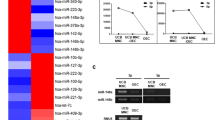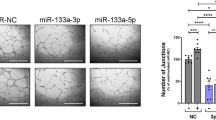Abstract
Although it is well established that tumors initiate an angiogenic switch, the molecular basis of this process remains incompletely understood. Here we show that the miRNA miR-132 acts as an angiogenic switch by targeting p120RasGAP in the endothelium and thereby inducing neovascularization. We identified miR-132 as a highly upregulated miRNA in a human embryonic stem cell model of vasculogenesis and found that miR-132 was highly expressed in the endothelium of human tumors and hemangiomas but was undetectable in normal endothelium. Ectopic expression of miR-132 in endothelial cells in vitro increased their proliferation and tube-forming capacity, whereas intraocular injection of an antagomir targeting miR-132, anti–miR-132, reduced postnatal retinal vascular development in mice. Among the top-ranking predicted targets of miR-132 was p120RasGAP, which we found to be expressed in normal but not tumor endothelium. Endothelial expression of miR-132 suppressed p120RasGAP expression and increased Ras activity, whereas a miRNA-resistant version of p120RasGAP reversed the vascular response induced by miR-132. Notably, administration of anti–miR-132 inhibited angiogenesis in wild-type mice but not in mice with an inducible deletion of Rasa1 (encoding p120RasGAP). Finally, vessel-targeted nanoparticle delivery1 of anti–miR-132 restored p120RasGAP expression in the tumor endothelium, suppressed angiogenesis and decreased tumor burden in an orthotopic xenograft mouse model of human breast carcinoma. We conclude that miR-132 acts as an angiogenic switch by suppressing endothelial p120RasGAP expression, leading to Ras activation and the induction of neovascularization, whereas the application of anti–miR-132 inhibits neovascularization by maintaining vessels in the resting state.
This is a preview of subscription content, access via your institution
Access options
Subscribe to this journal
Receive 12 print issues and online access
$209.00 per year
only $17.42 per issue
Buy this article
- Purchase on Springer Link
- Instant access to full article PDF
Prices may be subject to local taxes which are calculated during checkout




Similar content being viewed by others
References
Murphy, E.A. et al. Nanoparticle-mediated drug delivery to tumor vasculature suppresses metastasis. Proc. Natl. Acad. Sci. USA 105, 9343–9348 (2008).
Hobson, B. & Denekamp, J. Endothelial proliferation in tumours and normal tissues: continuous labelling studies. Br. J. Cancer 49, 405–413 (1984).
Folkman, J. The role of angiogenesis in tumor growth. Semin. Cancer Biol. 3, 65–71 (1992).
Fish, J.E. & Srivastava, D. MicroRNAs: opening a new vein in angiogenesis research. Sci. Signal. 2, pe1 (2009).
Lindquist, J.N., Cheresh, D.A. & Snyder, E.Y. Derivation of vasculature from embryonic stem cells. Curr. Protoc. Stem Cell Biol. 12, 1.1F.9.1–1.1F.9.6 (2010).
Kelly, M.A. & Hirschi, K.K. Signaling hierarchy regulating human endothelial cell development. Arterioscler. Thromb. Vasc. Biol. 29, 718–724 (2009).
Nudelman, A.S. et al. Neuronal activity rapidly induces transcription of the CREB-regulated microRNA-132, in vivo. Hippocampus 20, 492–498 (2010).
Vo, N. et al. A cAMP-response element binding protein–induced microRNA regulates neuronal morphogenesis. Proc. Natl. Acad. Sci. USA 102, 16426–16431 (2005).
Mayo, L.D., Kessler, K.M., Pincheira, R., Warren, R.S. & Donner, D.B. Vascular endothelial cell growth factor activates CRE-binding protein by signaling through the KDR receptor tyrosine kinase. J. Biol. Chem. 276, 25184–25189 (2001).
Tan, Y. et al. FGF and stress regulate CREB and ATF-1 via a pathway involving p38 MAP kinase and MAPKAP kinase-2. EMBO J. 15, 4629–4642 (1996).
Kenneth, T.E. & Kertes, P.J. Ranibizumab in neovascular age-related macular degeneration. Clin. Interv. Aging 1, 451–466 (2006).
Gragoudas, E.S., Adamis, A.P., Cunningham, E.T. Jr., Feinsod, M. & Guyer, D.R. Pegaptanib for neovascular age-related macular degeneration. N. Engl. J. Med. 351, 2805–2816 (2004).
Griffiths-Jones, S., Grocock, R.J., van Dongen, S., Bateman, A. & Enright, A.J. miRBase: microRNA sequences, targets and gene nomenclature. Nucleic Acids Res. 34, D140–D144 (2006).
Lewis, B.P., Burge, C.B. & Bartel, D.P. Conserved seed pairing, often flanked by adenosines, indicates that thousands of human genes are microRNA targets. Cell 120, 15–20 (2005).
Krek, A. et al. Combinatorial microRNA target predictions. Nat. Genet. 37, 495–500 (2005).
Rehmsmeier, M., Steffen, P., Hochsmann, M. & Giegerich, R. Fast and effective prediction of microRNA/target duplexes. RNA 10, 1507–1517 (2004).
Bartel, D.P. MicroRNAs: target recognition and regulatory functions. Cell 136, 215–233 (2009).
Hoshino, M., Kawakita, M. & Hattori, S. Characterization of a factor that stimulates hydrolysis of GTP bound to ras gene product p21 (GTPase-activating protein) and correlation of its activity to cell density. Mol. Cell. Biol. 8, 4169–4173 (1988).
McCormick, F. ras GTPase activating protein: signal transmitter and signal terminator. Cell 56, 5–8 (1989).
Lapinski, P.E. et al. Generation of mice with a conditional allele of the p120 Ras GTPase-activating protein. Genesis 45, 762–767 (2007).
Henkemeyer, M. et al. Vascular system defects and neuronal apoptosis in mice lacking ras GTPase-activating protein. Nature 377, 695–701 (1995).
Boon, L.M., Mulliken, J.B. & Vikkula, M. RASA1: variable phenotype with capillary and arteriovenous malformations. Curr. Opin. Genet. Dev. 15, 265–269 (2005).
Eerola, I. et al. Capillary malformation-arteriovenous malformation, a new clinical and genetic disorder caused by RASA1 mutations. Am. J. Hum. Genet. 73, 1240–1249 (2003).
Hershkovitz, D., Bercovich, D., Sprecher, E. & Lapidot, M. RASA1 mutations may cause hereditary capillary malformations without arteriovenous malformations. Br. J. Dermatol. 158, 1035–1040 (2008).
Hood, J.D. et al. Tumor regression by targeted gene delivery to the neovasculature. Science 296, 2404–2407 (2002).
Fish, J.E. et al. miR-126 regulates angiogenic signaling and vascular integrity. Dev. Cell 15, 272–284 (2008).
Harris, T.A., Yamakuchi, M., Ferlito, M., Mendell, J.T. & Lowenstein, C.J. MicroRNA-126 regulates endothelial expression of vascular cell adhesion molecule 1. Proc. Natl. Acad. Sci. USA 105, 1516–1521 (2008).
Wang, S. et al. The endothelial-specific microRNA miR-126 governs vascular integrity and angiogenesis. Dev. Cell 15, 261–271 (2008).
Würdinger, T. et al. miR-296 regulates growth factor receptor overexpression in angiogenic endothelial cells. Cancer Cell 14, 382–393 (2008).
Bonauer, A. et al. MicroRNA-92a controls angiogenesis and functional recovery of ischemic tissues in mice. Science 324, 1710–1713 (2009).
Komada, M. & Kitamura, N. The Hrs/STAM complex in the downregulation of receptor tyrosine kinases. J. Biochem. 137, 1–8 (2005).
Kulkarni, S.V., Gish, G., van der Geer, P., Henkemeyer, M. & Pawson, T. Role of p120 Ras-GAP in directed cell movement. J. Cell Biol. 149, 457–470 (2000).
Meadows, K.N., Bryant, P., Vincent, P.A. & Pumiglia, K.M. Activated Ras induces a proangiogenic phenotype in primary endothelial cells. Oncogene 23, 192–200 (2004).
Bergers, G. & Hanahan, D. Modes of resistance to anti-angiogenic therapy. Nat. Rev. Cancer 8, 592–603 (2008).
Munoz, R. et al. Highly efficacious nontoxic preclinical treatment for advanced metastatic breast cancer using combination oral UFT-cyclophosphamide metronomic chemotherapy. Cancer Res. 66, 3386–3391 (2006).
Koh, W., Stratman, A.N., Sacharidou, A. & Davis, G.E. In vitro three dimensional collagen matrix models of endothelial lumen formation during vasculogenesis and angiogenesis. Methods Enzymol. 443, 83–101 (2008).
Pena, J.T. et al. miRNA in situ hybridization in formaldehyde and EDC-fixed tissues. Nat. Methods 6, 139–141 (2009).
Scheppke, L. et al. Retinal vascular permeability suppression by topical application of a novel VEGFR2/Src kinase inhibitor in mice and rabbits. J. Clin. Invest. 118, 2337–2346 (2008).
Weis, S., Cui, J., Barnes, L. & Cheresh, D. Endothelial barrier disruption by VEGF-mediated Src activity potentiates tumor cell extravasation and metastasis. J. Cell Biol. 167, 223–229 (2004).
Desgrosellier, J.S. et al. An integrin αvβ3-c-Src oncogenic unit promotes anchorage-independence and tumor progression. Nat. Med. 15, 1163–1169 (2009).
Acknowledgements
We thank L. Barnes, E. Goka, B. Walsh and D. Wu for technical support. We thank S. Weng and J. Desgrosellier for discussions. We thank E. Brown (University of Pennsylvania) for the Ert2-ubiquitin-Cre mice. We thank R. Kerbel (University of Toronto) for the fast-growing variant of MDA-MB-231 breast carcinoma cells. We thank S. Kajiji (Scripps Research Institute) for FG human pancreatic adenocarcinoma cells. This work was supported by US National Institutes of Health grants HL078912, CA104898 and CA050286 to D.A.C. and HL096498 to P.D.K. S.A. is supported in part by an American Heart Association postdoctoral fellowship 09POST2040038.
Author information
Authors and Affiliations
Contributions
S.A. and D.A.C. designed the study. E.A.M., B.K.M. and R.M. designed the nanoparticles. J.N.L. established the human ES cell vasculogenesis model. D.J.S. helped with the TaqMan microRNA panel experiments and analysis. P.E.L. and P.D.K. generated and characterized the Rasa1fl/fl mice. S.A., L.S., L.M.A. and M.H. performed experiments and analyzed data. S.A., S.M.W. and D.A.C. analyzed data and wrote the manuscript. D.A.C. supervised the project.
Corresponding author
Ethics declarations
Competing interests
The authors declare no competing financial interests.
Supplementary information
Supplementary Text and Figures
Supplementary Figures 1–16 (PDF 3797 kb)
Rights and permissions
About this article
Cite this article
Anand, S., Majeti, B., Acevedo, L. et al. MicroRNA-132–mediated loss of p120RasGAP activates the endothelium to facilitate pathological angiogenesis. Nat Med 16, 909–914 (2010). https://doi.org/10.1038/nm.2186
Received:
Accepted:
Published:
Issue Date:
DOI: https://doi.org/10.1038/nm.2186
This article is cited by
-
The role of cardiac pericytes in health and disease: therapeutic targets for myocardial infarction
Nature Reviews Cardiology (2024)
-
Understanding molecular mechanisms and miRNA-based targets in diabetes foot ulcers
Molecular Biology Reports (2024)
-
MicroRNA-132 may be associated with blood pressure and liver steatosis—preliminary observations in obese individuals
Journal of Human Hypertension (2022)
-
MicroRNAs are involved in the development and progression of gastric cancer
Acta Pharmacologica Sinica (2021)
-
Hydrogel-mediated delivery of microRNA-92a inhibitor polyplex nanoparticles induces localized angiogenesis
Angiogenesis (2021)



